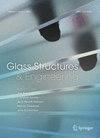大变形和长期载荷下标准PVB建模的简化方法
IF 1.5
Q3 CONSTRUCTION & BUILDING TECHNOLOGY
引用次数: 0
摘要
摘要夹层玻璃(LG)残余承载能力的数值模拟是目前结构玻璃设计中讨论较多但尚未得到充分解决的问题。根据CEN/TS 19100:2021 (2021a)和CEN/TS 19100:2021 (2021b),断裂后极限状态(PFLS)设计在实验和数值上都是可行的。实验验证需要大规模的组件测试,这通常是昂贵和耗时的。节省资源的数值方法是首选的。然而,目前在土木工程实践中,还没有一个完善的数值模型能够表征破碎夹层玻璃的复杂承载机理。这些机制是夹层的有限应变响应,玻璃碎片或碎片本身的接触,以及玻璃与夹层之间的结合。分层作用主要支配后者。本研究以标准单层聚乙烯醇丁醛(PVB)为例,重点研究了长载荷下聚合物夹层玻璃间层有限应变行为的实验、力学和数值表征。在此基础上,提出了一种简化LSG夹层数值模拟的方法。这些考虑依赖于实验和热力学考虑。本文章由计算机程序翻译,如有差异,请以英文原文为准。
Simplified approach for modeling standard PVB at large deformations and long-term loading
Abstract Recently, the numerical simulation of the residual load-bearing capacity of laminated glass (LG) is an often discussed but not sufficiently solved problem in structural glass design yet. According to CEN/TS 19100:2021 (2021a), and CEN/TS 19100:2021 (2021b), the design in the Post Fracture Limit State (PFLS) is possible experimentally and numerically. Experimental verification requires large-scale component tests, which are often costly and time-consuming. The resource-saving numerical approach is to be preferred. However, at the moment, there is no sound numerical model capable of representing the complex load-bearing mechanisms of broken laminated glass (LG) in civil engineering practice. These mechanisms are the finite-strain response of the interlayer, the contact between glass fragments or shards themselves, and the bond between glass and interlayer. Delamination governs the latter one mainly. This work focuses on the experimental, mechanical, and numerical characterization of the finite-strain behavior of polymeric laminated glass interlayers at long load durations by the example of standard single-layer Polyvinylbutyral (PVB). Based on that, it introduces an approach enabling the simplified numerical simulation of LSG interlayers. The considerations rely on experiments and thermodynamic considerations.
求助全文
通过发布文献求助,成功后即可免费获取论文全文。
去求助
来源期刊

Glass Structures & Engineering
CONSTRUCTION & BUILDING TECHNOLOGY-
CiteScore
3.50
自引率
26.30%
发文量
44
期刊介绍:
This journal provides an international forum for presentation and discussion of developments in structural glass research and their practical applications, offering a holistic approach to research, construction and engineering. Presenting review papers, technical notes, discussions, case studies and letters, the journal benefits researchers as well as designers and manufacturers of structural glass.The journal addresses all aspects of structural glass research including theoretical and experimental research on elements, assemblies, connections and material. Coverage includes Structural glass design philosophy & safety; Loads on glass structures; Stability of structural glass components; Glass in façades; Architectural geometries; IGUs, Automotive; Solar; Projects & case studies; Curved glass; Joints, fixings & adhesives; Strength & fracture mechanics; Laminated glass & composites; Post-fracture performance; Glass forensics and fractography; Post processing and more.
 求助内容:
求助内容: 应助结果提醒方式:
应助结果提醒方式:


